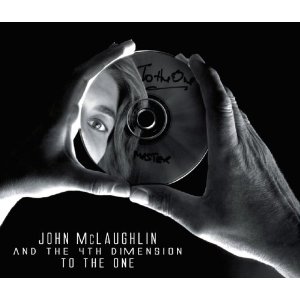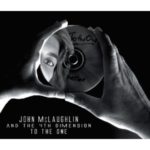
Abstract Logix
Surface details. In artistic terms, it is often important to see beneath the immediate, pondering the hidden imagery that lies deep within — impressionism triumphing over neo-realism, in a way. On initial listenings, veteran fusion guitarist John McLaughlin appears to be playing at such a fast clip, with so much controlled abandon, that his band members—indeed, the 4th Dimension—cannot seem to keep up with him. Instead, they chase the guitar maestro in a beleaguered attempt to parallel his warp speed course. And that can be quite a big problem at times in music, especially in jam, improvisational, or, in this case, post-jazz fusion soundscapes. One wants to be enveloped in the walls of sound which surround, and not have any lone instrument pull the third eye from the sonic fantasia. To hear one soloing, and just doing that, is akin to pointless, one-dimensional wanking.
Well, that is where the master’s touch really comes into play. The sorcerer himself appears to guide, rather than lead, embellish and accentuate, instead of showboating. McLaughlin dates back to the pre-fusion and funk era Miles Davis with his playing on the trumpeter’s In a Silent Way, as well as the landmark Bitches Brew albums. The guitarist also co-founded Maravishnu Orchestra, which institutionalized that entire jazz fusion concept, formalizing its trendsetting motifs, and, eventually, stifling its creativity. After one stumbles upon an innovative piece of work, or an entire new form of art, where does one go within the constraints of its definitive framework? Ahhh… the challenge of any innovator, let alone an improvisational musician living in a critical world.
On To the One, the first album with his 4th Dimension band, featuring Gary Husband on keyboards and percussion, Etienne M’Bappe on bass, and Mark Mondesir on drums, McLaughlin helms the daunting task of layering notes within a quartet framework, which is enhanced and textured by his band members, with none detracting from the other. On “Discovery,” the quartet circle, envelope, and stretch a main riff, which highlights the durable bass work of M’Bappe. “Special Beings” slows the pace down a bit, but this gives Husband a chance to add some warm colors to the overall portrait. “The Fine Line” returns to the dominant guitar-led riff structure and the 68-year old shows an ageless ability to toy and tweak a rhythm, until all shadings are pondered. Husband, again, shines on this piece, while Mondesir finally appears to catch up and overtake his band. But, all the pieces don’t always coalesce on this track.
“Lost and Found” features McLaughlin on guitar-synthesizer, and wallows in a mellow jazz vibe which is quite nice for a late evening fix. “Recovery” may be the one track where all four members are in unison from the first moment, and, in a sense, may be the album’s most satisfying piece. All four are playing at an impressive and exploratory pace, and none appear to be even remotely out of sync. The closing title track returns to a slower motif, warm and inviting, but nothing too exotic, or poignant, rises to the surface.
Surface details. It can detract from the overall artistic experience in any medium, especially in something as potentially self-indulgent as jazz fusion. On To the One, one of the originators of the form, the genre, if you will, finds a way to pull his listeners under the surface, and into that fourth dimensional point of view—whether it is some form of quantum physics space-time theorizing, or musicians completing a quartet. To shake the feeling that what one is listening to sounds familiar, and yet it is being executed by the man who helped create its shape and form, can boggle the noodle. Hence, a word of advice. Avoid the surface details, and seek the tapestry under the tracks on To the One.



No Comments comments associated with this post